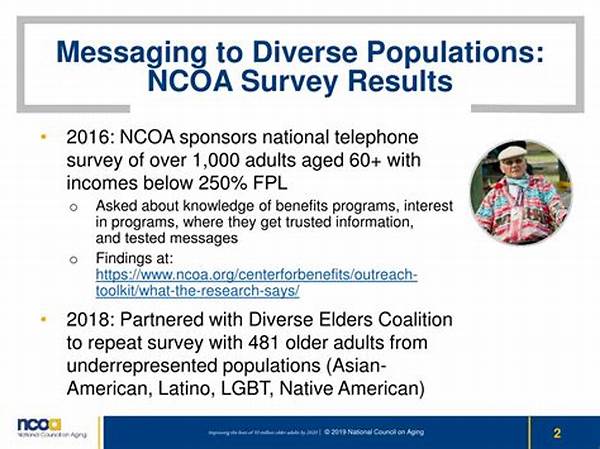In an increasingly interconnected world, communication across diverse populations has become more crucial than ever. As societies become more multicultural, understanding effective messaging strategies for diverse populations has emerged as a significant focus for professionals in various fields, including business, marketing, education, and public health. The challenge lies in navigating cultural nuances, linguistic differences, and varying value systems to convey messages that resonate with a broad audience without losing authenticity or effectiveness. This article delves into the complex landscape of messaging strategies tailored for diverse populations, highlighting critical approaches and considerations essential for success.
Read Now : Strategic Employee Development Plans
The Importance of Cultural Sensitivity in Messaging
Cultural sensitivity is paramount when developing messaging strategies for diverse populations. Messages must be crafted with a deep understanding of cultural norms, values, and beliefs that influence how they are perceived. A lack of cultural awareness can lead to misinterpretations, offense, or disengagement, undermining the intended communication goals. Therefore, it is essential to conduct thorough research and engage with cultural experts or representatives from target communities during the planning phase. Additionally, using inclusive language that acknowledges and respects differences fosters a sense of belonging and solidarity among diverse groups. By implementing culturally sensitive messaging strategies, organizations can build trust and rapport, ultimately enhancing the reach and impact of their communication efforts.
Best Practices for Effective Communication
1. Know Your Audience: Understanding the demographics, preferences, and values of your audience is crucial in formulating messaging strategies for diverse populations. Tailoring messages to align with shared experiences and expectations can significantly improve engagement.
2. Use Clear and Simple Language: Avoid jargon and complex terminologies that might not translate well across different cultures. Clarity in language ensures that the message is easily understood by all segments of your audience.
3. Emphasize Inclusivity: Messaging strategies for diverse populations should include representations from all targeted demographics. Inclusivity fosters a sense of recognition and respect, bridging gaps between different communities.
4. Leverage Multiple Channels: Different populations may prefer different communication channels. Utilize a mix of traditional and digital platforms to reach broader audiences effectively and ensure message dissemination.
5. Evaluate and Adjust: Continuously assess the effectiveness of your messaging strategies for diverse populations through feedback and performance metrics. Be prepared to adapt your approach based on the data received to maximize impact.
Overcoming Language Barriers
Overcoming language barriers is a critical component of effective messaging strategies for diverse populations. Language not only involves the words used but also encompasses non-verbal cues, tone, and context. To address language diversity, it is essential to employ skilled translators and interpreters who can convey the message accurately while maintaining cultural authenticity. Furthermore, producing multilingual content expands accessibility to non-native speakers, ensuring inclusivity in communication efforts. Employing visual aids, such as infographics or videos, can also enhance comprehension, making messages more relatable and easily digestible. Organizations that adeptly manage language barriers are better positioned to establish meaningful connections with diverse audiences, fostering mutual understanding and collaboration.
Read Now : How To Identify The Right Institution
Technology’s Role in Messaging
The advancement of technology has significantly transformed messaging strategies for diverse populations. Digital platforms provide innovative tools to tailor and deliver messages more effectively, accommodating various cultural preferences and needs. Technologies such as Artificial Intelligence (AI) and Machine Learning (ML) offer personalized messaging through the analysis of audience behavior and feedback. Social media platforms, with their powerful reach, allow for immediate interaction and engagement, offering opportunities for real-time feedback and message adjustment. Nevertheless, it is crucial to leverage technology with a human-centric approach, ensuring that digital messaging respects cultural nuances and personalizes content to maintain relevance and impact.
Case Study: Successful Messaging Strategies
A key example of effective messaging strategies for diverse populations can be seen in global health campaigns. Organizations such as the World Health Organization (WHO) have implemented successful campaigns by utilizing culturally relevant messages and collaborating with local communities. This approach involves local influencers or leaders who resonate with target populations, enhancing trust and message acceptance. Adaptation of messages to align with community values and practices ensures relevance and encourages prompt action. By combining local insights with global expertise, such campaigns exemplify how careful planning and execution of messaging strategies can yield positive outcomes across diverse populations.
Challenges and Considerations
While implementing messaging strategies for diverse populations, several challenges must be considered. Firstly, there is a potential risk of cultural appropriation if messages do not genuinely acknowledge and respect cultural heritage. Secondly, rapidly changing social dynamics require adaptable strategies that address emerging trends and issues. Additionally, ethical considerations surrounding data privacy must be adhered to when utilizing technology in crafting and disseminating messages. Adequately addressing these challenges is crucial for maintaining the integrity and effectiveness of communication efforts, ensuring that diverse populations are engaged, empowered, and respected.
Conclusion
In conclusion, the development of effective messaging strategies for diverse populations requires a multifaceted approach that prioritizes cultural sensitivity, inclusivity, and adaptability. By understanding audience demographics and preferences, employing clear and inclusive language, and utilizing diverse communication channels, organizations can enhance message reach and impact. Overcoming language barriers and leveraging technology with a mindful approach further bolster communication efforts. Successful examples demonstrate the power of integrating local insights with global expertise. By addressing potential challenges and continuously evaluating strategies, organizations are better equipped to engage with diverse populations, fostering understanding, collaboration, and unity across multicultural landscapes.
